#the poseidon adventure
Explore tagged Tumblr posts
Text

September 1973 cover
Artist: Norman Mingo Mad Logo Art: Harvey Kurtzman
254 notes
·
View notes
Text

Such a happy group of cruisers on the deck of the Poseidon
28 notes
·
View notes
Text
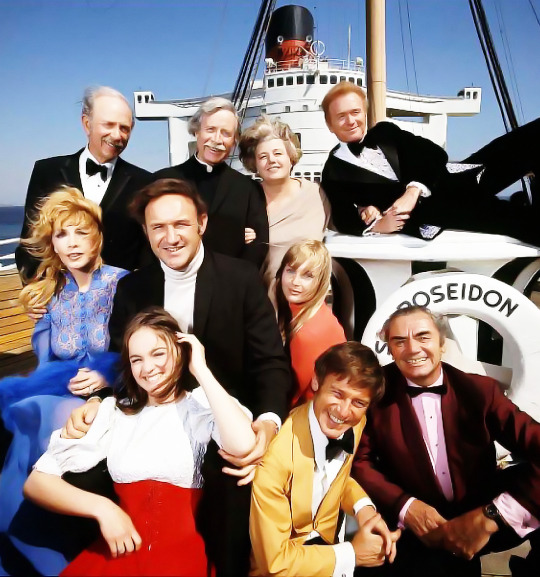
Stella Stevens, Carol Lynley, Gene Hackman, Shelley Winters, Pamela Sue Martin, Arthur O'Connell, Red Buttons, Roddy McDowall, Ernest Borgnine and Jack Albertson pose on deck of cruise ship for the 1972 Irwin Allen 'disaster' movie 'The Poseidon Adventure'.
#stella stevens#carol lynley#gene hackman#shelley winters#pamela sue martin#arthur o'connell#red buttons#roddy mcdowall#ernest borgnine#jack albertson#the poseidon adventure#70's#by lady hollywood
136 notes
·
View notes
Photo

The Poseidon Adventure, Italian lobby card (fotobusta), 1972
#submission#The Poseidon Adventure#Ronald Neame#Lobby Card#Lobby Cards#Fotobusta#Fotobuste#Gene Hackman#Ernest Borgnine#Shelley Winters
8 notes
·
View notes
Text
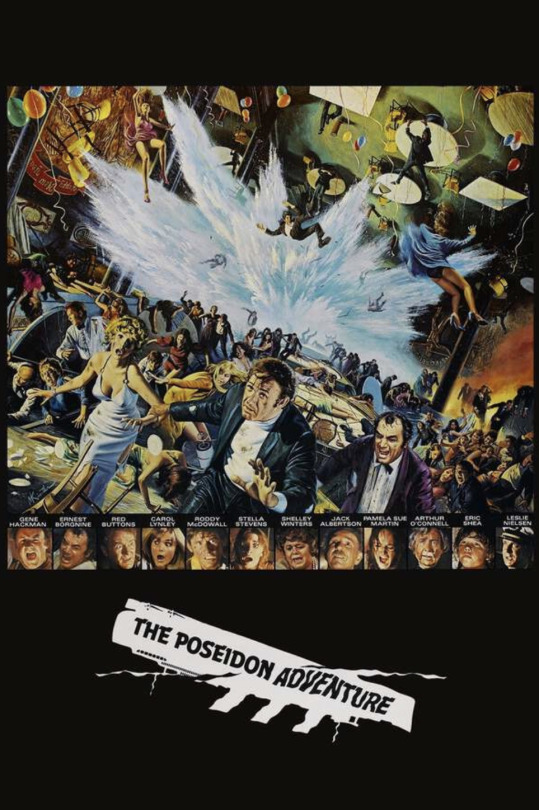
#movies#polls#the poseidon adventure#poseidon adventure#70s movies#ronald neame#gene hackman#ernest borgnine#requested#have you seen this movie poll
73 notes
·
View notes
Photo

R.I.P. Stella Stevens
149 notes
·
View notes
Text




HARLEY AND…SHELLEY WINTERS?
#dc comics#the poseidon adventure#shelley winters#poison ivy#harley quinn#harley and ivy#paul dini#bruce timm
7 notes
·
View notes
Text

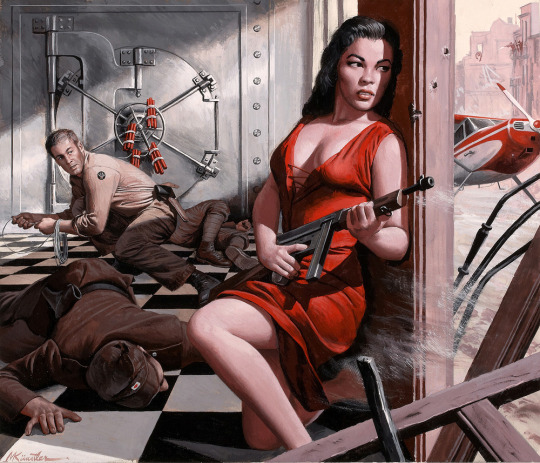


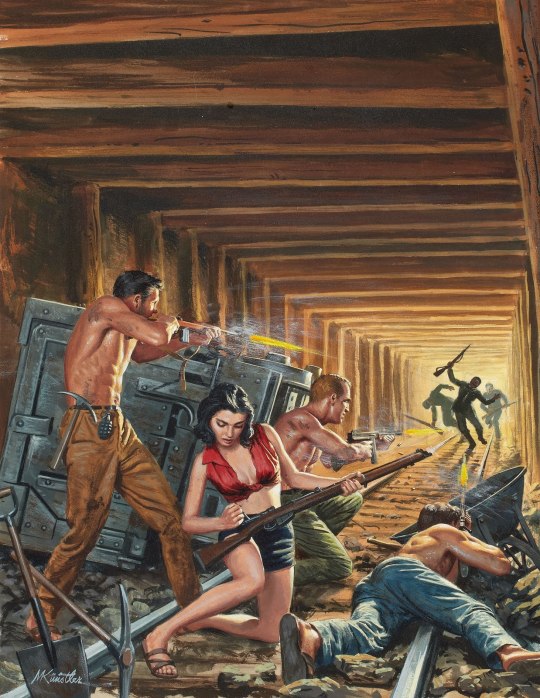



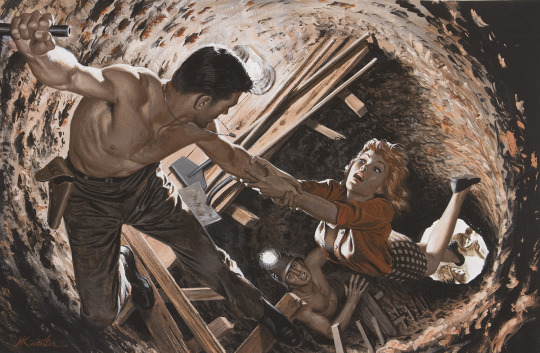






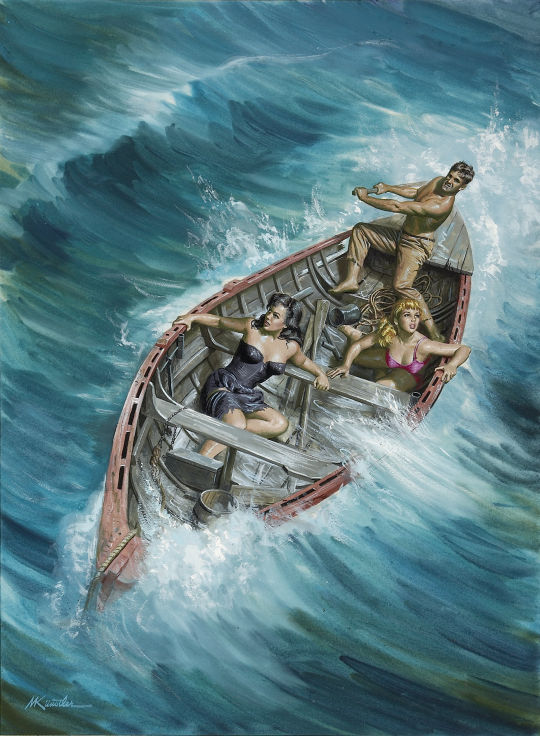
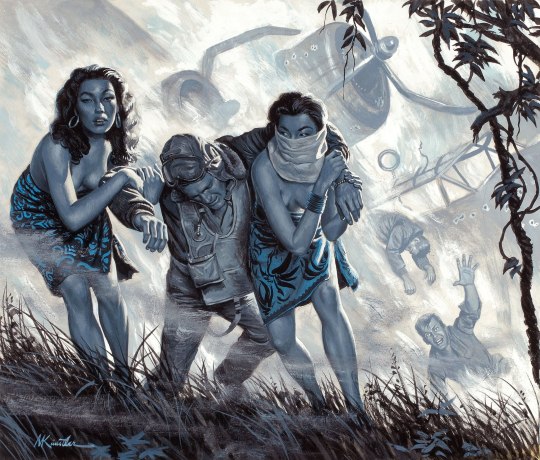


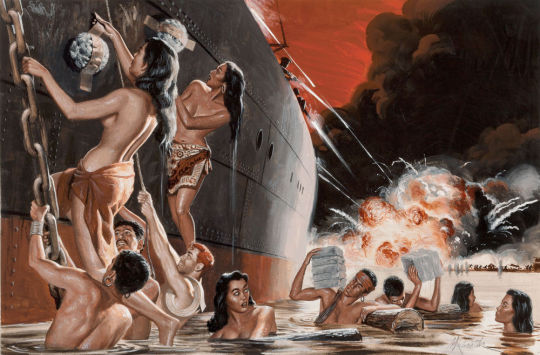

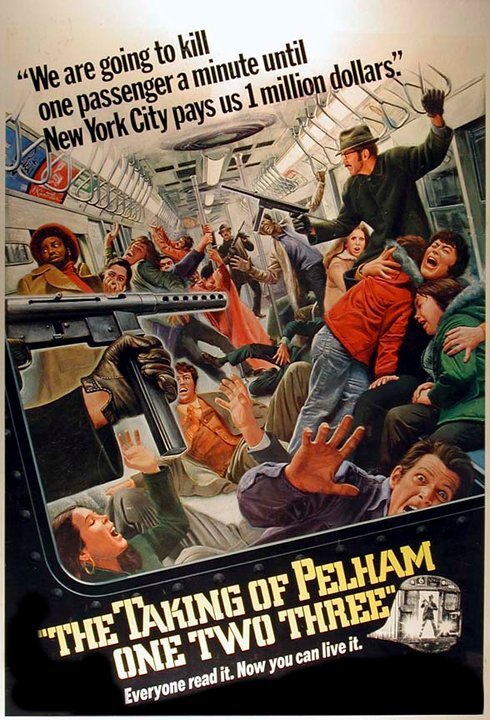
Showcasing art from some of my favourite artists, and those that have attracted my attention, in the field of visual arts, including vintage; pulp; pop culture; books and comics; concert posters; fantastical and imaginative realism; classical; contemporary; new contemporary; pop surrealism; conceptual and illustration.
The art of Mort Künstler.
#Art#Mort Kunstler#pulp#magazine#illustration#Imaginative Realism#The Poseidon Adventure#The Taking Of Pelham 1 2 3#movie poster#movie posters#Female#Feminine
90 notes
·
View notes
Text
I think Rian Johnson should take a page from 70's disaster movies and have a Knives Out story take place in a burning highrise or an upside down ship. Now it's both a mystery, and we get to see asshole rich people dying horribly! its a win-win!
9 notes
·
View notes
Text
On January 25, 1973, The Poseidon Adventure debuted in West Germany.




2 notes
·
View notes
Text

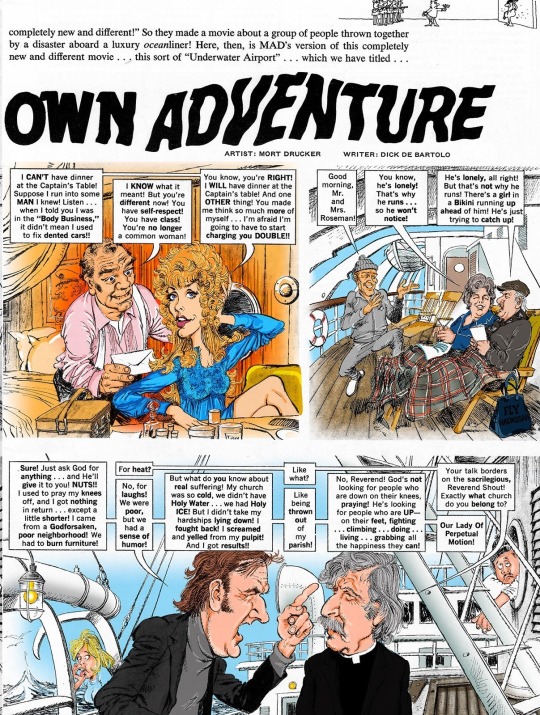
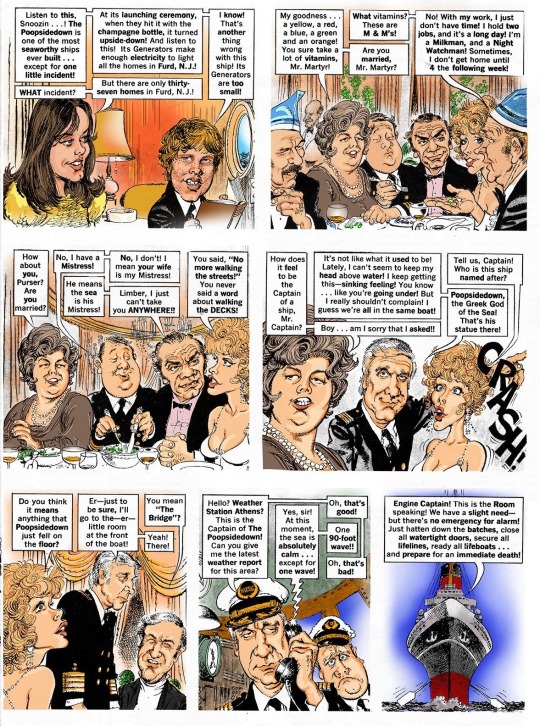





“The Poopsidedown Adventure” (MAD #161, September 1973)
Artist: Mort Drucker Writer: Dick DeBartolo
#Mad magazine#The Poseidon Adventure#movie parody#Gene Hackman#Ernest Borgnine#Shelley Winters#Jack Albertson#Stella Stevens#Roddy McDowall#Pamela Sue Martin#Carol Lynley
76 notes
·
View notes
Text
Poseidon (2006)

There are just enough moments in Poseidon that work to make you see the movie it could’ve been. Even then, there’d be no reason to watch it when the original The Poseidon Adventure is readily available. This movie has great special effects and a lame script full of dull characters you’ve seen a million times before.
On New Year’s Eve, the SS Poseidon capsizes after being hit by a huge, rogue wave. In the ballroom, a few of the survivors attempt to make their way to the bottom (now the top) of the ship, where they hope to be rescued.
This movie starts off on the wrong foot with the character who is essentially our protagonist: firefighter-turned-New York City Mayor Robert Ramsey (Kurt Russell). Ramsey is all upset when he walks into his room and sees his daughter Jennifer (Mike Vogel) and her boyfriend Christian (Mike Vogel) in an embrace. His ability to be a cliché is only eclipsed by douchebag gambler “Lucky” Larry (Kevin Dillon), who might as well walk onto the screen with a big “dead meat” sign hanging around his neck. We already have an “antagonist” in the form of the ship that’s upside down and slowly sinking. Why did writer Mark Protosevich feel the need to add all of these petty dramatic subplots and one-dimensional characters? I will be fair to Poseidon and say that some people’s deaths I didn’t see coming but for the most part, the passengers are such obvious types you know exactly what will happen to them the second they walk on-screen.
This is a remake of the 1972 film/an adaptation of the novel it was based on, but only loosely. Everyone we meet is new (which explains why none of them are interesting) and it’s only the concept of the ship being turned over that’s been retained. It feels like the opportunity to have some big, explosive visuals was the only reason this movie was made. To be fair, the special effects are some of the best 2006 had to offer. You get your money’s worth during the scenes where the ship gets flipped and everyone on the inside is sent flying through the air. There are also some good scenes of tension as the survivors desperately make their way through one obstacle after another. That said, some of those obstacles are ridiculous and would be insurmountable anywhere other than in a movie. There’s a particular scene where screws holding the cover to a large ventilation shaft have to be undone in record time to prevent everyone from drowning, and none of it is believable at all - not even for these artificial characters. Or maybe it would be believable in another movie, but here, it isn’t for the same reason that the original “The Poseidon Adventure” worked: The movie is too short. You never spend enough time with anyone to get to know them properly. When someone dies, it often feels rushed, or like the movie wishes you were more emotionally invested in them than you actually are.
Poseidon is not all bad but it’s forgettable. Even with the Academy Award-nominated special effects, you won’t be impressed because nowadays, it feels like we get movies like this one every other year: disaster flicks with plenty of vehicles/monuments/buildings destroyed that make you go “Ooh! Aah!” and then stop caring because the people in the middle of the action are afterthoughts. (February 3, 2023)

#Poseidon#movies#films#movie reviews#film reviews#Wolfgang Petersen#Mark Protosevich#The Poseidon Adventure#Paul Gallico#Kurt Russell#Josh Lucas#Richard Dreyfuss#Emmy Rossum#Jacinda Barrett#Mike Vogel#Mia Maestro#Jimmy Bennett#Andre Braugher#2006 movies#2006 films
2 notes
·
View notes
Text
so i have a soft spot for the 2006 film poseidon which is a film i reckon about 24 other people remember existing since warner bros lost like $70million on it, and i just like, need to talk about it.
its a loose remake of a 1972 film, and overall, its a very silly film, however its also connected to massive advancements in oceanography, and through that connection, also connected to an incident that could have killed around 10000 american recruits during ww2 in less than an hour.
and i cannot stop thinking about this stupid film so please enjoy this stupidly long post no one is going to read because I Need To Infodump.
so poseidon (2006)...
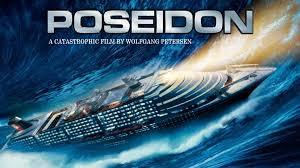
it's a very of its time disaster film with your group of plucky survivors trying to overcome more and more obstacles as they desperately fight for safety. among them, youve got kurt russell as an ex nyc firefighter and mayor because its 2006, of course you do. emmy rossums here because of course she is (again, its 2006), and surprise richard dreyfus is here as a gay naval architect who survives the film. fergie even has a cameo and its honestly a crime that the song she sings for it is not on spotify.
but the film is also very much not a of its time disaster film, because production decided to not update the setting. and i have absolutely no idea why. and its confused me for years now because its an easy fix.
see the 1972 film (the poseidon adventure) and the book its based on, both take place on an ocean liner, and that makes sense for that time.
contrary to popular beliefs, ocean liners =/= cruise ships.
during the late 19th century and most of the 20th century, ocean liners were all the rage, because if you wanted to go from liverpool to new york, they were your best bet.
with the invention of steam engines, they were no longer dependent on weather, and once wood was swapped for steel, they were at serious less risk of sinking. this meant they could run reliable trips from point a to point b and back again. they were essentially buses for the ocean. thats what titanic was btw.
while less popular due to jet travel in the 70s, people were still using them. the ss michelangelo sailed her maiden voyage in 1965, and ran for ten years still. it does make sense for both the book and film to take place on an ocean liner.
it does not make sense for the 2006 iteration to take place on an ocean liner, but it does. and its not even an ocean liner turned cruise ship like the rms queen mary 2 or the ss france/ss norway. there were no ocean liner only businesses operating in 2006 because you can now take a plane rather than a five day trip across the atlantic.
but in poseidon (2006), the rms poseidon is not a cruise ship. it is an ocean liner, and designating it as rms means it is also delivering international royal mail. theres even a plot about a stowaway aboard the ship which is just a tad bit bizarre. its such an odd choice not to simply update it so its a cruise ship. most people dont know the difference between them, theres no reason to specify that it is an ocean liner.
(its especially odd because the gay naval architect apparently knows the vessel very well which, sir, who is paying you to draft up ocean liner designs in 2006??)
weirdly enough though, the film does decide to update the actual cause for the disaster, which will bring us back to the ww2 point.
the general gist of the story is that some environmental event causes the ship to capsize (turn upside down in the water), and our heroes have to escape the ship.
i have attempted to read the book, but i didnt enjoy it and i was getting a feeling that the author, paul gallico, was antisemitic. he was. he specifically expressed it by saying jewish folks love basketball because its a game specialised for tricky characters, to paraphrase. yeah no theres also basketball antisemitism going on.
in the book, its an underwater earthquake that causes the ship to capsize. the quake created a 90ft wave (put a pin in that, we'll get back to it) which i believe hit the ship side-on, after the ship fell into a deep trough.
i have no idea if this is possible irl as im just an autistic with a special interest in ocean liners.
in the 1972 film, its a tsunami that hits the ship. i believe the tsunami is also caused by an underwater earthquake (again, put a pin in that) which would hit the ship on the side and cause it to roll right over (put a pin in this too btw).
again, i dont know about the veracity of this happening irl. i know tsunamis are related to underwater earthquakes, but as far as i know, they dont form into the massive wave until the wave is closer to shore?
but anyway, in the 2006 film, the capsizing is caused by a rogue wave.
as aforementioned, my special interest is ocean liners so i know quite a lot about rogue waves and i dont know how much of that is common knowledge so time for another abrupt explanation of niche topics.
so rogue waves, what are they? well, theyre big fuck off waves. descriptions tend to put them anywhere from 50ft high to 100ft (10 stories high).
for a wave to be considered a rogue wave, it needs to be more than twice the height of any other wave in that region. theyre unpredictable and often occur out of nowhere. theyre more common in some specific regions like off the coast of south africa, and are distinct from tsunamis. they can occur both in the ocean and on the great lakes.
for centuries, sailors have told tales of them but like krakens and sea monsters, they werent believed. this is partly due to survivorship bias because if youre in a wooden sailboat and get hit by a rogue wave, youre not going to survive. it was only after advancements in ship building that people began to survive them. and even then, its not guaranteed.
some theorise rogue waves were responsible for the sinking of both the ss munich/munchen and the edmund fitzgerald.
still, it wasnt until one was recorded by a research post in 1995 that rogue waves genuinely became a serious topic within oceanography.
however, we did have credible reports of them hitting ocean liners long before then. both the rms lusitania (in 1910) and the ss michelangelo (in 1966) were badly damaged when they ran into rogue waves bow first (head-on). they both fell into deep troughs before the wave hit and both of their bows sustained serious damage. three people lost their lives on the ss michelangelo.
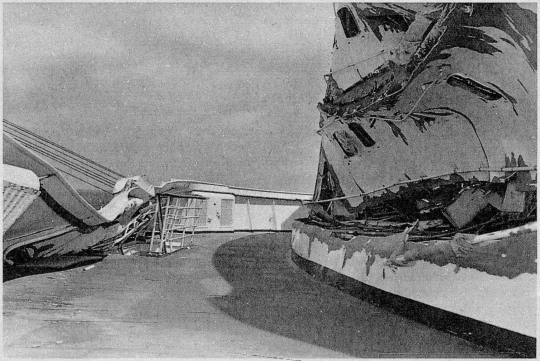
(damage done to ss michelangelo)
despite this, it was preferable for both vessels to hit the wave head-on. both were ocean liners with bows designed to break through waves, and designed to be able to keep sailing even if the bow was caved in.
(fun fact: if titanic had hit the iceberg head on, there was a very good chance she wouldnt have sunk)
now you might want to know why we know it was preferable to be hit head-on, and why i specified the ship would have been hit side-on. this is how the ship was hit in the 2006 film also. and well, this is when were getting into ww2 territory.
the lusitania and michelangelo are not the only ocean liners to encounter a rogue wave. this also happened to the rms queen mary in 1942.
just some quick background on the queen mary; she was launched in 1936 and built with the goal of stealing the blue riband (the record for fastest journey for a passenger line from southampton to new york) from the ss normandie, owned by french line. queen mary was owned by the cunard line whose reputation partly rested on speed. both the lusitania and mauritania (both cunard ships) had won the blue riband at some point. in 1942, queen mary held the blue riband and was considered the fastest passenger liner in the world.

at that point though, she has been requisitioned by the admiralty for the war effort and was acting as a troop ship. a very effective troop ship as she averaged 28 knots in speed and they managed to up her capacity from around 3300 (including crew) to 16000.
she also was owned by cunard line who have a long history of conferring with the admiralty during peacetimes. their ships were designed with spaces left for guns and weapons. part of why the lusitania was sunk by a u-boat in ww1 was her secretly carrying firearms back from the "neutral" america to the uk despite it still being a passenger ship. the admiralty knew queen mary would be a massive benefit in a war.
this isnt to say that she was perfect, however. she was a famous roller. see, when youre building a ship, you expect it to roll somewhat on any difficult seas. to combat extreme rolling (which can be fatal), ships are built with their centres of buoyancy and gravity close together. this reduces rolling, but can cause very sudden lists (tilts). as queen mary was a big fuck off ship, it was assumed she wouldnt roll badly, so she was designed with a slightly bigger gap between those centres which caused very slow rolling from side to side. this often felt like the ship would never right itself, and as handrails were not considered necessary at first, passengers had to shuffle down hallways.
cunard took her in for repairs and added stabilisers to lessen the roll. they also added handrails. it didnt fix the rolling, but it was bearable and not considered dangerous. she soon became a superstar liner, and again, a very good troop ship.
hitler had even put a monetary bounty specifically on the queen mary for whichever submarine could shoot her, with the iron cross promised also. this did not come to pass.

(rms queen mary as a troopship)
what did come to pass, however, was a 92ft high rogue wave smashing into her portside (left). this is the absolute opposite of what you want to happen.
there was an attempt to steer her head-on into the wave but ocean liners that size take two miles to stop moving. they also couldnt risk too sudden of a turn because they were in the atlantic in a storm. this attempt to change course is repeated in the 2006 film and is also unsuccessful.
so now when the wave hit queen mary, it caused her to begin listing to starboard (right side) because a 90ft ocean wave just smashed into her. and she began to list. the portholes broke and wager poured in, making the list worst.
at first, it was 15°, then 20°, then 25°, 30°, 40°, 50°, 52°
then she stopped. and she stayed there, listing 52° to starboard. she was nearly capsized. and what must have felt like hours for those 11000 recruits and crew, she just stayed there, nearly on her side in the atlantic ocean.
and then finally, she began to right herself, one degree at a time, until she was back steady as if nothing had happened.
the technicians had later examined the ship and estimated that if shed listed just 3° extra, they would have capsized and sank, taking 11000 men with her.
so i imagine at this point, if youre even reading this anymore, youre like okay, kai, we get it, you dont wanna get hit broadside by a rogue wave, do we need all this detail?
and well, no. you dont need to know it and i dont need to tell it but here i am, telling you so.
but it is very relevant to poseidon (2006) because remember how its a remake of a film based on a book? and that book was written by the basketball antisemite? yeah, so paul gallico was on board the queen mary when this happened.
and this is what inspired him to write the book.
obviously, at the time, we didnt fully understand rogue waves so gallico explained it as an underwater earthquake, but we know now it was a rogue wave.
and so the 2006 film honours that and makes it a rogue wave. they never really explain it so unless youre insufferable like me, you might just be like what the fuck? is that poseidon (god) doing that?
but im gonna redirect your attention to the fact that the queen mary was 3° away from capsizing and that 3° could have caused an entirely different outcome to the war.
if she had capsized, she would have taken 10000 recruits with her and the allies would have lost their best troop ship. morale would have been affected because back then, ocean liners were household celebrities. they were adored by residents.
im not a historian, and especially not a war historian, so im not gonna be like oh look alternate history where the nazis won oooh how edgy?
but like, just a few more feet of water on that wave and parts of ww2 would be so different.
also, gallico would have died so his book wouldnt have existed, neither would the film adaptation or the remake. it all just comes back around like a never ending carousel of feral seahorses.
it also would have affected the cunard line massively after the war, and the white star line (titanics owners) as well. i believe their merger was after ww2.
[Edit: The Cunard White Star merger took place in 1934 and the hull for the RMS Queen Mary was already laid down before the merger took place.]
but anyway, away from all the existential crises. i wanted to actually address what made me want to write this stupidly long post in the first place:
an article i skim read that addressed the veracity of the inciting event in the 2006 film, aka the rogue wave.
after a mostly accurate explanation of rogue waves and at least one misuse of cruise ship for ocean liner, the article concluded that a rogue wave hitting an ocean liner like that was simply so unlikely, it was basically impossible.
and if youve got this far in my ramblings, you might be able to understand the level of bafflement i felt reading that.
because while it is a fair conclusion as it is a very unlikely thing to happen. but THIS FILM EXISTS BECAUSE A ROGUE WAVE SMASHED INTO AN OCEAN LINER AND NEARLY CAPSIZED IT
#kai rambles#a lot#long post#very long post#this is just me infodumping into the void#poseidon (2006)#the poseidon adventure#tw antisemitism#rms queen mary#ss normandie#ss michelangelo#rms lusitania#rms mauritania#rms titanic#titanic#ocean liners#SpIns#ww2#rogue waves#tw adolf hitler#tw nazis#tw ww2#ss munich#edmund fitzgerald#my autism is singing sea shanties tonight lads#anyway#im glad the gay survived the action film in 2006#shipposting
42 notes
·
View notes
Text

Today in 1972, the movie "The Poseidon Adventure" opens.
2 notes
·
View notes
Photo

The Poseidon Adventure, Italian lobby card (fotobusta), 1972
#submission#The Poseidon Adventure#Ronald Neame#Lobby Card#Lobby Cards#Fotobusta#Fotobuste#Gene Hackman#Ernest Borgnine#Shelley Winters
2 notes
·
View notes
Text
youtube
Hi Guys,
Tonight Boys 'n' Ghouls Film Review Podcast reviews The Poseidon Adventure Mini Movies here. https://youtu.be/ucxk_a6joPw via YouTube
#boys n ghouls film review podcast#boys n ghouls film review#boys n ghouls#The Poseidon Adventure#Action#Adventure#Movie Reviews#Film Reviews#Film Critic#Podcasts#Podcasters#Podcasting#YouTube#Youtube
5 notes
·
View notes